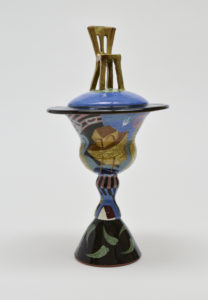Elijah Cup
Robert Lipnick (b. 1958)
Ceramic, h. 5 3/5 x w. 3 ½ in.
United States, 1991
B’nai B’rith Klutznick National Jewish Museum Collection, 1992.007
Passover, or Pesach, is a seven-day festival that marks the beginning of spring and recalls the exodus of the Jewish people from Egypt. The Passover seder, meaning order, retells the story of the exodus from Egypt and rich symbolism appears throughout. Near the end of the seder, a cup of wine is poured for Elijah the Prophet and the front door is opened to welcome Elijah into the home. Elijah is often associated with a protective, peaceful presence and he is thought to be the prophet who will announce the advent of the Messianic age, a time of peace.
The custom of opening the door began in the second century, when Pesach eve was also called “the Night of Watching.” The door was left open as if participants were ready to leave at a moment’s notice. Today, the door is opened for just a few minutes and the custom became associated with Elijah, an advocate for social justice and a champion of the poor, who, legend says, visits the seder each year.
Also in the second century, a disagreement arose as to whether there should be four or five cups of wine. When a decision couldn’t be reached, it was decided to have four cups to drink and an additional symbolic cup, designated as the cup of Elijah. According to tradition, the first thing Elijah will do after he returns to the Jewish people to proclaim the advent of the messianic age is to resolve all questions of Jewish law that confounded the rabbis.
The colors of Richard Lipnick’s Elijah Cup represent earth, water, and sky. Abstract imagery suggests animal and plant forms and may symbolize creation and the creative process. The fitted lid of the cup is topped with a golden chair representing charity to humankind. On Passover, this chair is reserved for Elijah but is left empty for anyone needing a meal. In discussing this work, Lipnick wrote, “In my dream, next year is a better place.”
Lipnick earned a Bachelor of Science from the University of Maryland and a Masters of Fine Arts from the University of Notre Dame, Lipnick is a familiar, widely respected educator throughout eastern Iowa, and has taught for such area institutions as Scott Community College, Clinton Community College, and Marycrest College. The artist has had his pieces displayed nationally at venues including the Figge Art Museum, Minneapolis Art Institute and the Jewish Museum in New York City. Lipnick remains an active proponent for art education.
Publications:
For Every Thing A Season: Jewish Ritual Art In Cleveland, exh. cat., Cleveland State University, 2000, #146.

